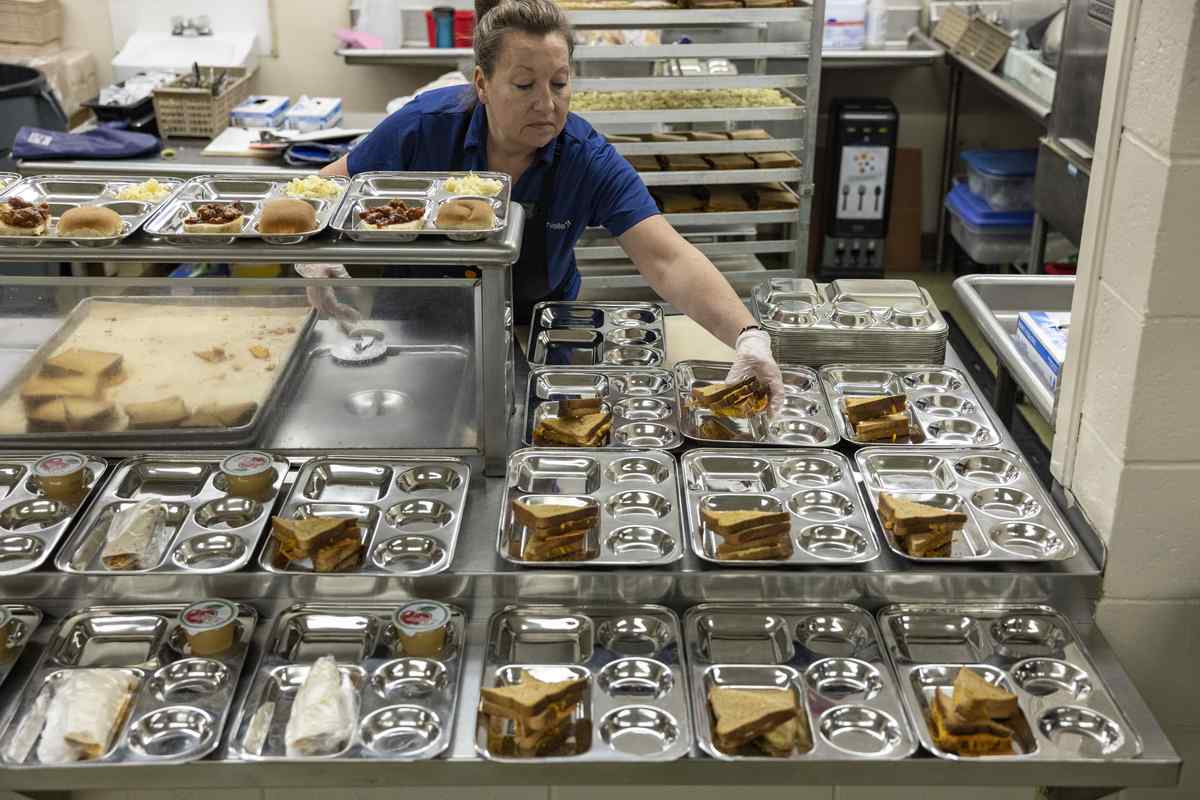
Brown Avenue Elementary in Johnston, Rhode Island, is going plastic-free by using reusable trays and silverware during lunchtime.
16:14 JST, January 5, 2025
JOHNSTON, R.I. – Brown Avenue Elementary’s cafeteria looks just like any other, except for one thing.
Dotted throughout the noisy lunchroom, new stainless steel trays now carry the lunches children eat. They’re shiny, durable and, most importantly, reusable.
One month ago, the school of just over 200 students switched out its plastic-foam trays for silver ones, and replaced its plastic utensils with metal sporks. It’s a small change, but it has cut its lunch waste 90 percent, from nine 50-gallon bags to one-third of a bag.
The change stems from Rhode Island’s plastic-foam ban, which took effect on Jan. 1 and mandates that food-service establishments cannot prepare or provide food in plastic-foam containers. These polystyrene foam containers are made of styrene, a chemical that the Food and Drug Administration has labeled a possible carcinogen that can leach into hot food. Plastic foam is also hard to recycle and can take up to 500 years to degrade.
But the material is cheap and convenient, which is why most schools across the country use single-use trays to feed the nearly 30 million children who eat school lunches every year, according to Manasa Mantravadi, a pediatrician and founder of the stainless steel dinnerware brand Ahimsa.
For a school like Brown Avenue, with a small kitchen and only one permanent kitchen staff member, plastic-foam trays have certainly been the easier option. The switch to stainless steel trays required an investment of time, money and effort as staff and students adjusted to reusable ones. But four weeks later, both students and staff have fallen into a routine and embraced the new trays.
How it works
If you ask students why they prefer steel trays, “less trash” is the most common answer. Rhode Island has just one landfill, located three miles from the school.
“It helps the landfill and it’s better for the environment,” said fifth-grader Mia Amaral. “And the old trays used to fall apart, they would bend or break.”
The new trays are heavier and slightly bigger than the plastic-foam ones, but fifth-grader Lucas Halton said the old trays were so lightweight they “used to fly.”
Now that the trays need to be returned at the end of lunch, the school is tackling food waste, too. At the end of lunch before winter break, a handful of students, including Amaral, hurried excitedly to the waste station. These student volunteers – called “rangers” – donned green compostable gloves and waited to help their classmates sort their leftovers.
One ranger put the sporks into a soapy tray, so they weren’t accidentally tossed out. The next student took the milk cartons from each student and drained any remaining liquids into a bucket.
Brown Avenue’s cafeteria isn’t completely plastic-free. Fruit cups and mozzarella sticks still come in plastic packaging and disposable plastic bottles accompany many lunches. One ranger put the clean and recyclable plastics into the recycling bin.
Anything that couldn’t be recycled was thrown in the trash can. The remaining food on the tray was dumped into a compost bin. Amaral, the last ranger, stacked all the trays neatly so a kitchen staff member could easily grab it at the end.
Students said that after sorting waste at school, they now think about recycling and composting at home.
“We’re not supposed to throw away stuff we can recycle,” fifth-grader Joe Breit said.
Making the switch
Switching to these trays was an easy decision for Helina Dlugon, who has served as Brown Avenue’s principal for 23 years. Every day, she runs the lunch operation, calling up students in groups to grab their lunches and again at the end of lunch to clean up in five minutes.
As a daughter of Polish immigrants on a Pennsylvania farm, Dlugon said she grew up recycling, composting and taking care of land. She watched as her father would pick up any stray cans he saw lying around and recycle them.
“People in my position have an opportunity to make a change,” she said. “And if somebody is willing to put their necks forward to make that change, others will follow.”
The new lunch-ware required buying 150 stainless steel trays and just over $1,000, Dlugon said. A grant from the Rhode Island Education Department covered the cost.
Because Brown Avenue already had a dishwasher, it was better suited to take on this transition. As the trays are returned to the kitchen throughout lunch, kitchen staff member Nancy Carlton places them on a rack in a hatch-like dishwasher that can wash a dozen per minute, she said, and the trays have added only 15 minutes to her day. Compostable trays serve as a backup option in case they run out of steel ones.
School officials project they will save $3,500 per school year, after accounting for the new trays and extra staff time. Kelly DeAngelis, a facilitator with the Rhode Island School Recycling Project, who helped Brown Avenue make the switch, said that the school’s experience has inspired others in the district to follow suit.
Switching to a reusable option is better for children’s health and often the school’s budget, said Plastic Free Restaurants founder John Charles Meyer, whose group provides funding to kitchens throughout the country to replace single-use plastic. But it takes work to convince administrators to invest time and effort into the transition.
“I’ve learned when speaking to schools, you do not lead with the environment,” Meyer said. “What you lead with is, ‘Your school is poisoning your children.’”
Children are especially vulnerable to chemical leaching and microplastics because of their hormonal development, Mantravadi said.
“They’re not just toxic for the planet, they’re toxic for human health,” she said.
Several cities and states besides Rhode Island have plastic-foam bans, including Maryland and the District of Columbia. And Meyer’s organization has partnered with other groups, like Rethink Disposable and the Center for Environmental Health, to eliminate 13 million single-use plastics from over 150 restaurants and schools across 13 states. Change is slow, according to Meyer, though some Democratic members of Congress are pushing to ban plastic foam nationwide by 2026.
“When you see states like Rhode Island having formal bans, what that does is it allows real enforcement of the science, and then funding to follow,” Mantravadi said.
"News Services" POPULAR ARTICLE
-

American Playwright Jeremy O. Harris Arrested in Japan on Alleged Drug Smuggling
-

Japan’s Nikkei Stock Average as JGB Yields, Yen Rise on Rate-Hike Bets
-

Japan’s Nikkei Stock Average Licks Wounds after Selloff Sparked by BOJ Hike Bets (UPDATE 1)
-

Japan’s Nikkei Stock Average Buoyed by Stable Yen; SoftBank’s Slide Caps Gains (UPDATE 1)
-

Japanese Bond Yields Zoom, Stocks Slide as Rate Hike Looms
JN ACCESS RANKING
-

Tokyo Economic Security Forum to Hold Inaugural Meeting Amid Tense Global Environment
-

Keidanren Chairman Yoshinobu Tsutsui Visits Kashiwazaki-Kariwa Nuclear Power Plant; Inspects New Emergency Safety System
-

Imports of Rare Earths from China Facing Delays, May Be Caused by Deterioration of Japan-China Relations
-

University of Tokyo Professor Discusses Japanese Economic Security in Interview Ahead of Forum
-

Japan Pulls out of Vietnam Nuclear Project, Complicating Hanoi’s Power Plans
























